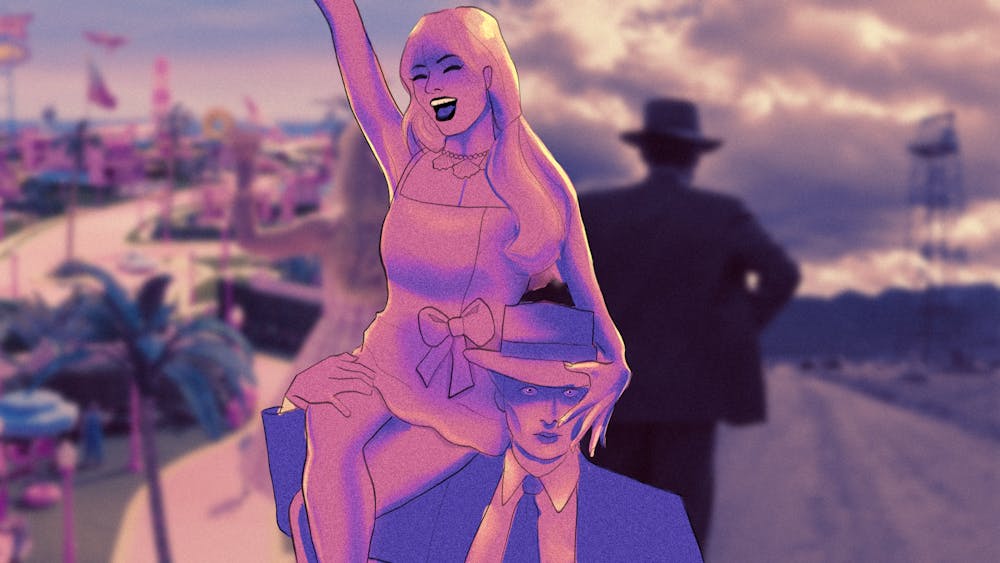Every once in a while, a great movie battle shakes the foundations of the Internet. There are classics like Star Wars vs. Star Trek. There was the Epic Rap Battles of History duel between Steven Spielberg and Alfred Hitchcock (and Quentin Tarantino, Stanley Kubrick, and Michael Bay). But in 2023, the film gods have blessed audiences with an instant classic: Barbenheimer.
Barbenheimer, for the five of you who have spent all summer under a rock, is an online phenomenon based around the same July 21 release date of two seemingly–polar–opposite films: Barbie and Oppenheimer.
The Internet’s fascination with the officially dubbed “Barbenheimer” seemingly began earlier this year, with many people on social media noticing how the films would be released on the same date, a fact which has not gone without scrutiny. Oppenheimer director Christopher Nolan recently ended a nearly two–decade with Barbie’s distributor, Warner Bros., after the 2020 release of his film, Tenet. While Nolan’s films typically release in mid–July, some speculated that Barbie was scheduled to release on the same day to cannibalize box office sales.
Regardless, the term—and trend—went viral, largely because Barbenheimer tapped into a gendered debate across the Internet: Oppenheimer catered to a traditionally male aesthetic, while Barbie showcased powerful femininity. In fact, while Barbie creates a utopian world of female empowerment, Oppenheimer doesn’t even pass the Bechdel test.
And thus, the Internet was off to the races. Quickly, hundreds of fan–made posters were created, and message boards abounded with debates on which order to watch the movies, and what to wear for what was quickly becoming the film event of the year.
More fuel was poured onto the fire as the two films’ casts leaned into the Barbenheimer craze. Interviewers regularly asked stars—like Barbie’s Margot Robbie and Oppenheimer’s Cillian Murphy—for their thoughts on the trend as it went mainstream. Most admitted to knowing about the phenomenon, and Robbie even confessed that she sends friends Barbenheimer memes. Studio marketing efforts—especially Barbie’s partnerships—provided even more material to be memed.
But as Barbenheimer approached, a final wrench was thrown in the works: two weeks before the movies were slated to come out, SAG–AFTRA—a union that represents over 100,000 performers and media professionals—went on strike, limiting the promotional efforts cast members could participate in, and leading to some stars walking out of premieres midway through. It seemed as though the biggest movie event in years would arrive during one of Hollywood’s bleakest moments in decades.
Yet in the days before July 21, nothing could stop Barbenheimer. Despite the labor disputes that ground most of Hollywood to a halt, the summer release schedule trundled on, largely due to months of content studios had finished and were ready to release. People—myself included—planned to watch the two movies back–to–back, sparking new debates on the preferred viewing order (I did Oppenheimer first, and highly recommend this choice). And beyond just a normal double feature, this one should ideally have a costume change in the middle. Anything pink is the Internet’s preferred attire for Barbie, while Oppenheimer is best paired with a suit, ideally black.
While I did not wear a suit to Oppenheimer, and my pink was not very hot compared to the rest of the Barbie crowd, I did get a pretty good taste of Barbenheimer last Friday. It lives up to the hype. Not only were both films utterly fantastic, the experience was exactly what I thought it would be: extremely entertaining. The Oppenheimer crowd was respectful and deferential, while Barbie’s was raucous. The idea of watching one movie and immediately driving to another theater to watch another might seem insane, but Barbenheimer made it worth it with the two films’ unique and transcendent approaches to their respective genres.
With the idea of watching both Barbie and Oppenheimer as close to each other as possible, the Internet got the last laugh over any multi–billion dollar studio. By turning Barbenheimer into a giant meme, both films did better at the box office than what was projected. Barbie is approaching $400 million globally, and had the highest–grossing domestic opening weekend for a female director. This is successful enough for Mattel to plan a whopping 45 more toy–related adaptations of its properties. Oppenheimer is no slouch, either, making $86 million domestically on its own opening weekend—well above predictions. Beyond this, the two combined to create the largest weekend at the box office since Avengers: Endgame was released over four years ago, and fourth biggest of all–time.
To make things more interesting, neither film is the action or superhero fare which has dominated the box office in recent years—Barbie is a fantasy comedy and Oppenheimer is a three–hour, R–rated biopic—making the pair's success more attributable to the Barbenheimer phenomenon. In an age where original studio projects like The Nice Guys and ambitious tentpoles like The Lone Ranger routinely bomb in theaters, people are showing Hollywood that with a little help from the Twitterati, high–budget, creative films can succeed outside of a franchise, one meme at a time.







